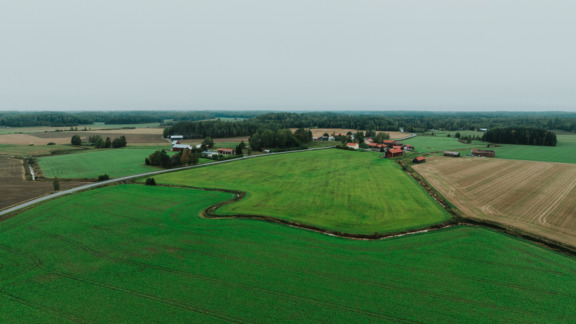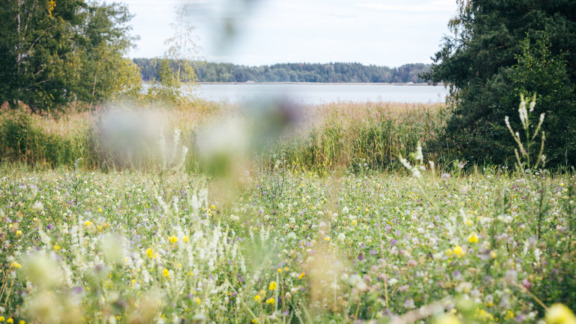Regenerative farming on Carbon Action farms
Regenerative farming and its effects on soil health are monitored on a hundred Carbon Action farms. The farmers on these pilot farms have already gained experience in regenerative and carbon farming methods for several growing seasons.
WHAT?
Regenerative farming and carbon farming are being piloted on a hundred Finnish farms. The evidence indicates that even minor changes improve yield levels and productivity. It’s essential to take the entire farm and its operations into account.
WHO?
Different types of farms in various production sectors across Finland. Farmers have been participating in Carbon Action research led by BSAG for several years.
WHY?
The aim is for all the farms to produce data suitable for research. The farmers are conducting experiments and developing measures to improve soil health to maximise carbon sequestration.
Improving profitability
Jari Eerola, who owns Setälä-Eerola Farm, got involved in the Carbon Action collaboration in 2018. He wanted to discover new perspectives on farming, as continuing with the old model no longer seemed sensible.
Production costs and workloads were increasing at the same rate as income was falling, and the farm’s profitability was suffering. Many of his colleagues threw in the towel, but Eerola didn’t want to do that. His family farm was established in the 1600s, so he felt it was a matter of honour to keep it going.
The farm is in Tuulos, on the outskirts of Hämeenlinna, and about 80 per cent of its fields are covered with plants during the winter. When a field has continuous plant cover – or is covered by plants for as long as possible – essential nutrients do not leach into bodies of water during heavy rainfall or when the snow thaws. Plants and their roots help retain valuable topsoil, reducing soil erosion. Eerola primarily adopted regenerative farming methods to make savings on fertiliser costs. However, as he learned more about soil health, he switched attention to microbiology and microorganism activity. His holistic approach to farm management has gradually led to a broader understanding of the importance of soil health in food production
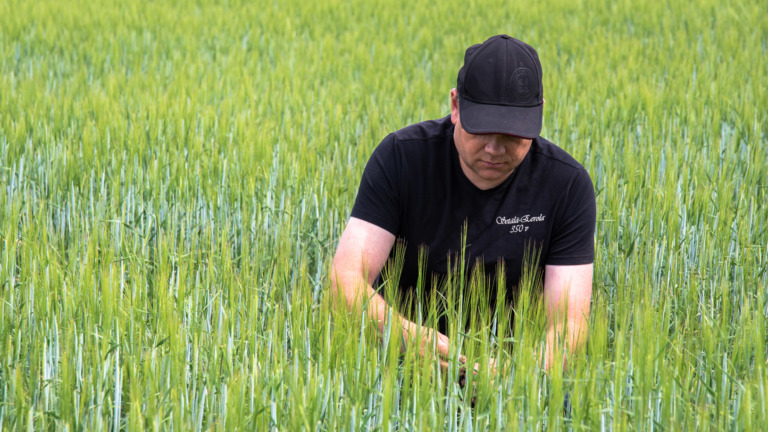
Transitioning to regenerative farming has required us to change our mindset. Soil health provides a buffer that maintains yield capacity. Which means our need for chemical inputs is now remarkably low, and that improves the functioning of the entire food chain.
Jari Eerola, farmer, Setälä-Eerola Farm
Small changes make a difference
Sirkku Puumala and Patrick Nyström, who run Verkatakkila Farm in Vihti, also wanted to experiment and learn new things. The couple has been taking proactive measures to improve their farm’s soil health for several years.
Verkatakkila Farm has about 200 hectares of arable land, in which they cultivate malting barley, caraway, autumn wheat, autumn rye, broad beans and grass. The farm’s owners are particularly motivated by the idea that even small changes can impact yield. One of their priority measures was to get their water management in order. Crop rotation was diversified, and the grass was added as a soil improver. The fields’ improved soil structure has safeguarded yield reliability in changing weather conditions.
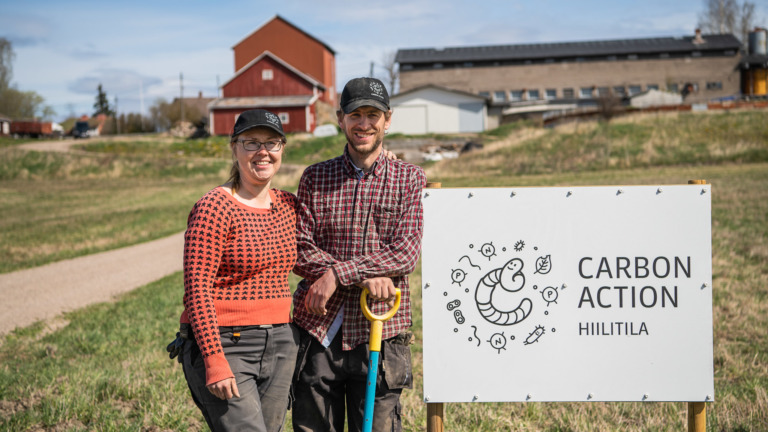
It’s empowering to see how you can influence soil health yourself. You’re not just at the mercy of the weather.
Sirkku Puumala, farmer, Verkatakkila Farm, Vihti
It pays to be environmentally friendly
Petri and Piia Jokela own the Jokela Farm in Nurmijärvi. They were also attracted to the idea of regenerative farming, as it enables you to run a profitable farm and protect nature simultaneously.
Approximately 147 hectares of oats, barley and other cereals are cultivated in Jokela. Fertilisation is based on beneficial grasses and their fertilising effect during crop rotation.
The Jokelas invest in biodiversity, and the farm provides shelter and sustenance for many different organisms. Solutions don’t have to be particularly large-scale or complex, as diversity can be increased through small actions. The farm has old buildings, trees, and diverse vegetation around the edges of fields. Environmental protection and productivity go hand in hand for this couple. Production needs to be profitable and improve soil health; therefore, the couple aims at profitability and various environmental benefits.
Carbon Action combines good business with nature conservation. You can farm in an environmentally friendly manner and still manage financially.
Petri Jokela, farmer, Jokela Farm, Nurmijärvi
An organic veteran in regenerative farming
Tommi Hasu, the young owner of Luomu-Mattinen Farm, also joined the Carbon Action project hoping to learn new things.
The Luomu-Mattinen family farm is located on the banks of the River Kymi in Oravala, where people have been farming the land since the 1500s. Organic farming has been practised on the farm since 1996. There are about 400 hectares, including rented fields and 300 suckler cows. The farm also manages the forest and sells wood to the surrounding areas.
Hasu advocates taking a step-by-step approach to regenerative farming and carbon farming. It’s worth getting to know your fields thoroughly, as each plot of land is unique. New methods are always introduced based on a field’s starting points.
I was raised to be an organic farmer. You can’t make major changes overnight if you earn your livelihood from farming. You must experiment and take everything step by step.
Tommi Hasu, farmer, Luomu-Mattinen, Oravala
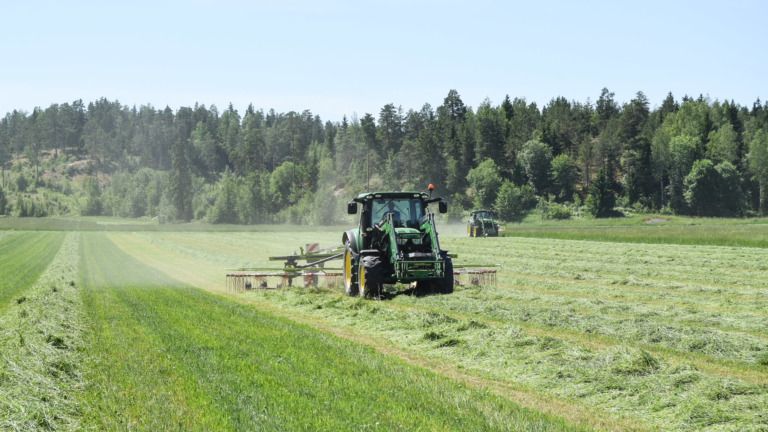
Catch crops improve soil health in many ways
Verkatakkila Farm in Vihti monitors the benefits of catch crops regarding soil health.
Catch crops bind nutrients that cultivated crops have not used. Adding them to the crop rotation following regenerative farming principles is a multi-benefit practice, as catch crops remain in the field and continue to photosynthesise even after the harvest.
Catch crops can also be used to maintain plant cover for as long as possible. They effectively combat weeds and improve the structure of the soil.
Managing a farm like a company or a team
Many farms have grown and developed enormously over the past few years. This requires farmers to manage large entities, to be systematic, and to be able to learn new things.
There are farms of different sizes with different profiles. They are in different locations. They have different climates, different fields, and different soils and crops.
Individual cultivation measures still don’t generate holistic benefits. Flexibly combining good farming practices as the situation requires – coupled with the courage to try new things – is essential in regenerative farming. This is also called adaptive farming.
Farmers on Carbon Action farms have gained much practical experience in how well-planned holistic and adaptive farming supports wellbeing. Farmers have reported an increased sense of autonomy due to their reduced need to make external purchases.
Nowadays, I think of myself as a coach, and the fields, animals and other employees are like my team members. Everyone in the team must feel good to get good results, and that good form must last all year round.
Tommi Hasu, farmer, Luomu-Mattinen, Oravala
Small steps towards a functional whole
Regenerative farming is not rocket science – it’s within everyone’s reach. Any farm can be farmed regeneratively. The main thing is to think about the farm as a whole. You can progress towards regenerative farming one small step at a time. Regenerative farming creates a long-term cycle of improvement for the entire arable ecosystem.


